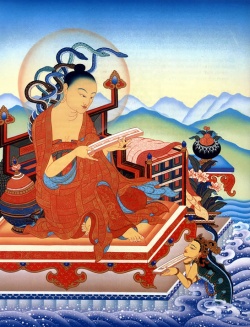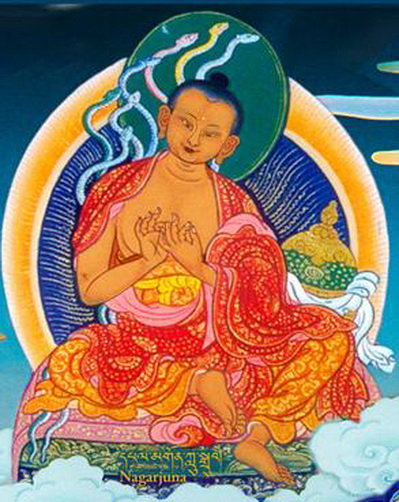Difference between revisions of "Nagarjuna (Jp. Ryuju)"
| (6 intermediate revisions by 3 users not shown) | |||
| Line 1: | Line 1: | ||
[[File:Nagarjuna1.jpg|thumb|250px|]] | [[File:Nagarjuna1.jpg|thumb|250px|]] | ||
| − | [[Nagarjuna]] (Jp. Ryuju) | + | [[Nagarjuna]] (Jp. [[Ryuju]]) |
| + | |||
| + | According to [[tradition]], [[Nagarjuna]] was the first [[Mahayana]] [[patriarch]] to advocate the [[Pure Land]] way and [[Vasubandhu]] is attributed with [[being]] the first to explain it clearly. One of the greatest of all [[Buddhist]] [[teachers]], [[Nagarjuna]] was a [[Mahayana]] [[scholar]] in southern [[India]] who is [[thought]] to have lived between AD. 150 and 250. He is especially known for his systematization of the [[doctrine]] of [[shunyata]] ([[non-substantiality]]). His [[philosophy]] was called the [[Madhyamika]] [[doctrine]]. Because of his overwhelming authority, he is also claimed as a [[patriarch]] by many other sects and schools. [[Nagarjuna]] is important to the [[Pure Land]] [[tradition]] for his treatise the [[Shih-chu-p'i-p'o-sha lun]] which praises [[Amida]] [[Buddha]] and advocates {{Wiki|recitation}} of his [[name]] as the quick and easy [[path]] of [[faith]] (Williams, 257). However, there have been [[doubts]] raised as to whether the [[Shih-chu-p'i-p'o-sha lun]] was really written by [[Nagarjuna]] since there are no [[Sanskrit]] or [[Tibetan]] extant copies (Hirakawa, 1957). | ||
| + | |||
| + | [[Image:Nagarjuna17.JPG|frame]] | ||
| + | '''[[Nagarjuna]]''' (Skt. ''[[Nāgārjuna]]''; Tib. {{BigTibetan|[[ཀླུ་སྒྲུབ་]]}}, ''[[ludrup]]''; [[Wyl.]] ''[[klu sgrub]]'') - one of the six great commentators (the ‘[[Six Ornaments]]’) on the [[Buddha’s teachings]], the great [[scholar]] [[Nagarjuna]] (c.150-250) is revered as an [[unsurpassed]] [[master]] by all [[Buddhist]] schools. His teachings provide the foundation for the [[Madhyamika]] School, which propounds the ‘[[Middle Way]]’ [[philosophy]], accepted as the [[highest]] [[view]] within the [[sutrayana]]. He was also the revealer of the [[Prajñaparamita]] [[Sutra]]s, the core [[teaching]] of the [[second turning of the wheel]] of the [[Dharma]]. He is also counted among the [[eighty-four mahasiddhas]], and among the [[eight vidyadharas]]. | ||
| + | |||
| + | [[Dilgo Khyentse Rinpoche]] said: | ||
| + | |||
| + | :[[Noble]] [[Nagarjuna]] was like a [[second buddha]] in this [[world]]. He composed commentaries explaining all the [[Buddha’s]] [[views]]. The [[Six Ornaments and Two Supreme Ones]] of the [[noble]] land of [[India]] asserted that there is no difference between [[Nagarjuna’s]] commentaries and the [[Buddha’s teachings]]. This is because [[Nagarjuna’s]] commentaries cover all [[three turnings]] of the [[wheel]] as well as the secret-mantra [[vajrayana]]. | ||
| + | |||
| + | ==Writings== | ||
| + | ===Collections==={{Tibetan}} | ||
| + | [[Nagarjuna's]] writings mainly employ {{Wiki|reasoning}} in order to clarify the [[view]] and the conduct of the [[Buddhist teachings]]. His writings are categorized into three collections, corresponding to the [[three turnings]] of the [[wheel]] of the [[Dharma]]. These three collections are: | ||
| + | |||
| + | *[[Collection of Advice]] | ||
| + | **[[Precious Garland]] -- advice on how to conduct one's [[life]] and how [[to construct]] {{Wiki|social}} policies that reflect [[Buddhist]] ideals. | ||
| + | **[[Letter to a Friend]] -- a concise and comprehensive introduction to the entire [[path]] and practice of [[Buddhism]]. | ||
| + | **[[Tree of Wisdom]] -- commentary of manners or [[moral]] maxim. | ||
| + | **[[A Hundred Wisdoms]] | ||
| + | **[[Drops for Healing Beings]] | ||
| + | **[[Commentary on Bodhichitta]] (Skt. [[Bodhicitta-vivarana]]; Tib. {{BigTibetan|[[བྱང་ཆུབ་སེམས་ཀྱི་འགྲེལ་བ་]]}}, [[Wyl.]] ''[[byang chub sems kyi ‘grel ba]]'') | ||
| + | **[[Sutrasamucchaya|Anthology or Compendium of Sutras]] (Skt. [[Sutrasamuccaya]]; Tib. {{BigTibetan|[[མདོ་ཀུན་ལས་བཏུས་པ་]]}}, [[Wyl.]] ''[[mdo kun las btus pa]]'') | ||
| + | |||
| + | *[[Collection of Middle Way Reasoning]] | ||
| + | *[[Collection of Praises]] | ||
| + | **[[Praise to the Dharmadhatu]] | ||
| + | **[[Praise of the Supramundane]] | ||
| + | **[[Praise of the Inconceivable]] | ||
| + | **[[Praise of the Ultimate]] | ||
| + | |||
| + | ==Further Reading== | ||
| + | *''[[Master]] of [[Wisdom]], Writings of the [[Buddhist Master]] [[Nagarjuna]]'', translations by {{Wiki|Christian}} Lindtner, [[Dharma]] Publishing, 1986 | ||
| + | *David Seyfort Ruegg, ''The {{Wiki|Literature}} of the [[Madhyamaka School]] of [[Philosophy]] in [[India]]'', Wiesbaden: Harrassowitz, 1981, pp. 4-49 | ||
| + | *[[Lobsang N. Tsonawa]], ''[[Indian]] [[Buddhist]] [[Pandits]] from The [[Jewel]] Garland of [[Buddhist]] History'', {{Wiki|Dharamsala}}: {{Wiki|Library of Tibetan Works and Archives}}, 1985. | ||
| + | |||
| + | ==External Links== | ||
| + | <!--DEAD: | ||
| + | *[http://www.lotsawaschool.org/nagarjuna_quotes.html Important quotes from the writings of Nagarjuna] --> | ||
| + | *[http://www.berzinarchives.com/web/en/archives/approaching_buddhism/teachers/lineage_masters/biography_nagarjuna.html A brief biography of Nagarjuna by Alexander Berzin] | ||
| + | *{{LH|indian-masters/nagarjuna|Nagarjuna Series on Lotsawa House}} | ||
| + | *{{TBRC|P4954|TBRC Profile of Nagarjuna}} | ||
| − | |||
{{R}} | {{R}} | ||
[http://jsri.jp/English/Pureland/LINEAGE/india.html jsri.jp] | [http://jsri.jp/English/Pureland/LINEAGE/india.html jsri.jp] | ||
Latest revision as of 00:53, 3 September 2014
According to tradition, Nagarjuna was the first Mahayana patriarch to advocate the Pure Land way and Vasubandhu is attributed with being the first to explain it clearly. One of the greatest of all Buddhist teachers, Nagarjuna was a Mahayana scholar in southern India who is thought to have lived between AD. 150 and 250. He is especially known for his systematization of the doctrine of shunyata (non-substantiality). His philosophy was called the Madhyamika doctrine. Because of his overwhelming authority, he is also claimed as a patriarch by many other sects and schools. Nagarjuna is important to the Pure Land tradition for his treatise the Shih-chu-p'i-p'o-sha lun which praises Amida Buddha and advocates recitation of his name as the quick and easy path of faith (Williams, 257). However, there have been doubts raised as to whether the Shih-chu-p'i-p'o-sha lun was really written by Nagarjuna since there are no Sanskrit or Tibetan extant copies (Hirakawa, 1957).
Nagarjuna (Skt. Nāgārjuna; Tib. ཀླུ་སྒྲུབ་, ludrup; Wyl. klu sgrub) - one of the six great commentators (the ‘Six Ornaments’) on the Buddha’s teachings, the great scholar Nagarjuna (c.150-250) is revered as an unsurpassed master by all Buddhist schools. His teachings provide the foundation for the Madhyamika School, which propounds the ‘Middle Way’ philosophy, accepted as the highest view within the sutrayana. He was also the revealer of the Prajñaparamita Sutras, the core teaching of the second turning of the wheel of the Dharma. He is also counted among the eighty-four mahasiddhas, and among the eight vidyadharas.
Dilgo Khyentse Rinpoche said:
- Noble Nagarjuna was like a second buddha in this world. He composed commentaries explaining all the Buddha’s views. The Six Ornaments and Two Supreme Ones of the noble land of India asserted that there is no difference between Nagarjuna’s commentaries and the Buddha’s teachings. This is because Nagarjuna’s commentaries cover all three turnings of the wheel as well as the secret-mantra vajrayana.
Writings
===Collections===Template:Tibetan Nagarjuna's writings mainly employ reasoning in order to clarify the view and the conduct of the Buddhist teachings. His writings are categorized into three collections, corresponding to the three turnings of the wheel of the Dharma. These three collections are:
- Collection of Advice
- Precious Garland -- advice on how to conduct one's life and how to construct social policies that reflect Buddhist ideals.
- Letter to a Friend -- a concise and comprehensive introduction to the entire path and practice of Buddhism.
- Tree of Wisdom -- commentary of manners or moral maxim.
- A Hundred Wisdoms
- Drops for Healing Beings
- Commentary on Bodhichitta (Skt. Bodhicitta-vivarana; Tib. བྱང་ཆུབ་སེམས་ཀྱི་འགྲེལ་བ་, Wyl. byang chub sems kyi ‘grel ba)
- Anthology or Compendium of Sutras (Skt. Sutrasamuccaya; Tib. མདོ་ཀུན་ལས་བཏུས་པ་, Wyl. mdo kun las btus pa)
Further Reading
- Master of Wisdom, Writings of the Buddhist Master Nagarjuna, translations by Christian Lindtner, Dharma Publishing, 1986
- David Seyfort Ruegg, The Literature of the Madhyamaka School of Philosophy in India, Wiesbaden: Harrassowitz, 1981, pp. 4-49
- Lobsang N. Tsonawa, Indian Buddhist Pandits from The Jewel Garland of Buddhist History, Dharamsala: Library of Tibetan Works and Archives, 1985.
External Links
- A brief biography of Nagarjuna by Alexander Berzin
- Nagarjuna Series on Lotsawa House
 TBRC Profile of Nagarjuna
TBRC Profile of Nagarjuna

